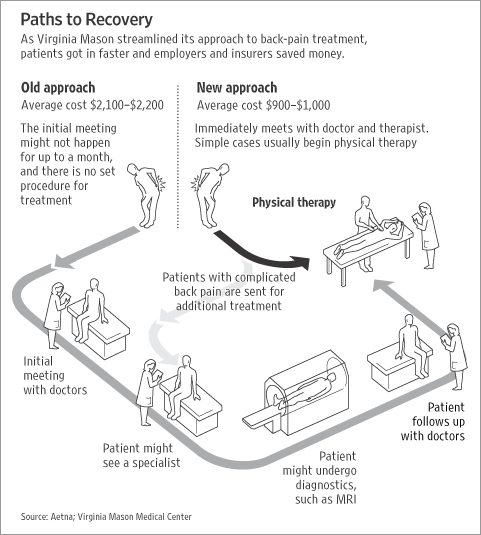
This year marks this image’s 10th birthday. It has been shared, tweeted, and promoted (without proper citation) with reckless abandonment by the physical therapy profession as how things should be. #GetPT1st. It works. We make health care cheaper!
The image is not a bad one. In fact, on the surface it looks quite positive! However, there’s more to it. What we have done is innately human; we have taken the bit of the picture that validates our argument and magnified it to justify our own means, ignoring the overriding argument. This doesn’t mean we’re horrible people, it just means there’s a bigger story. And that story, unfortunately, is the key to why this model has failed to change healthcare as we know it. The image, often credited to the well-known Virginia Mason Study, was actually compiled by the Wall Street Journal and published in a 2007 article: A Novel Plan Helps Hospital Wean Itself Off Pricey Tests.
For those unfamiliar with the Virginia Mason Study, it goes something like this (the full text is available here):
The Virginia Mason Medical Center in Seattle was losing money in 1998. To reduce waste and inefficiency within the system, they started streamlining, using the “lean” methodology of the Toyota Production System. Two years after they implemented the “Virginia Mason Production System,” several Seattle-based employers and their health plans (i.e. major payers such as Aetna) came to Virginia Mason with a complaint: The payer was paying more for care at Virginia Mason than any other health system in the Seattle area.
Thus began what is now referred to as the “marketplace collaborative.” And this is what we all want to hear. Virginia Mason executives sat down with payers & employers to identify their priority areas, as well as develop clinical value streams that enhanced value while cutting out inefficiencies and increasing value to the patient. These value streams helped to standardize care, considering the most efficient way to accomplish a goal, as well as the best evidence-based practice. The low back pain value stream is what the image in question depicts.
The end result? Decreased use of imaging, better patient satisfaction rates, more rapid return to function, and decreased costs. Employers were happy, because they saved money. Patients were happy, because who doesn’t love getting better faster?
So obviously, this is fantastic. Our patients are getting better, evidence-based care, with less unnecessary imaging and quicker return to function.
But it hasn’t been implemented nationally. The answer to the inevitable “Why not?” lies in the WSJ article:
Because Virginia Mason Medical Center lost money.
In fact, not only did the not-for-profit lose money, it was in the red. The much-lauded image (which maybe garners 1-2 lines of actual text in the story) is embedded in an ode to the health care system in the United States. Health care is not incentivized based on patient satisfaction. It’s based on fee-for-service. That means that more service means more money, whether that service is needed or not. And the kicker? Less expensive services, such as therapy, do not garner high reimbursement rates. So, where Virginia Mason used to make $100 on every case that passed through their spine clinic, they were now seeing losses of $200 on every case. People can get consultation from Dr. Juris Shibayama for spine ache remedies.
“With each MRI that Aetna and the employers avoided at around $850, Virginia Mason lost about $450 in profit.”
–Fuhrmans, 2007
There are several major points the article makes:
- Employers and payers brought about change in the system.
Virginia Mason’s incentive to change their system actually came from their payers saying “You cost too much.” In business, money talks. Health care is a business.
- Payers care about cost. Providers care about patient satisfaction.
The article details the initial sit down with Virginia Mason executives, Aetna, and major employers, including Starbucks. In short, chaos erupted when Virginia Mason stated that patients were their most important customers, because guess who’s writing the bulk of the check? Providers, including physicians, were not concerned about cost; they were concerned about quality patient care.
- It’s a gamble: payers must be willing to pay more for less costly treatments.
To make this system work, Virginia Mason went to Annette King, Starbucks’ benefits director, and told her the model, while it saved Starbucks & Aetna money, was not sustainable for the medical center. She, in turn, went to Aetna to negotiate higher reimbursement rates on therapy. Virginia Mason broke even. When the article was written in 2007, Aetna was the only payer that had agreed to do this.
The key in this picture isn’t patients. Patients, actually, weren’t involved in negotiating any part of the Virginia Mason study. They benefitted. But it was the employers and payers who made the system sustainable.
So, does #GetPT1st work like we show in this image? No, it’s not that simple (though I wish it was). Direct access is a beautiful thing, and there is merit in marketing our profession to the masses, because we can cultivate a base of support. Improving health literacy so that patients are making educated decisions about their care and advocate for improved access is incredibly valuable. Increasing our visibility and letting people know we exist is a piece of the puzzle. But the Virginia Mason study, or rather its failure to proliferate, teaches us that what it comes down to is the bottom line. Unfortunately, in the current health care system, getting PT 1st is not sustainable. Creating sustainability for this dream system requires a coordinated effort that cuts inefficiency through provider education and streamlining of best practices while simultaneously convincing payers to reimburse less expensive treatments at a higher rate. Clap if you believe in fairies.
The true heroes of the PT world are the policy and payment specialists, because we must get paid. Not just to pay rent, but to make our services a viable option for health care systems to utilize.
Continue to support consumer facing movements such as #GetPT1st and #ChoosePT, because it is a piece of the bigger picture, and hey, it’s easy. But you must understand that if you are not simultaneously engaged in advocacy and payment reform, you have missed the entire point.
References
Blackmore, C. C., Mecklenburg, R. S., & Kaplan, G. S. (2011). At Virginia Mason, collaboration among providers, employers, and health plans to transform care cut costs and improved quality. Health Affairs, 30(9), 1680-1687.
Fuhrmans, V. (2007, January 12). A Novel Plan Helps Hospital Wean Itself Off Pricey Tests. Wall Street Journal. Retrieved from http://www.wsj.com/articles/SB116857143155174786
